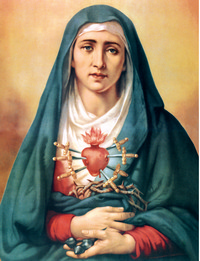Lives of the Saints
Our Models and Protectors
Spiritual Bouquet:
September 15

The Seven Sorrows
of the Blessed Virgin Mary
The Church twice commemorates the sorrows of its heavenly Mother. The Friday of Passion week, since the 15th century, has also been dedicated by the universal Church to Her Compassion. Why is this so? To understand this double liturgy, we must know that Mary is also the Mother of the Mystical Body. The present feast was instituted by Pius VII after his return from his captivity and exile, which lasted from 1809 to 1814. Christ no longer suffers, and for Our Lady also, all suffering as we understand it has ceased. Nonetheless, the prophet Jeremias in his Lamentations, asks: To whom shall You be compared, O Virgin? Your affliction is like the ocean. A mother who is happy in her home weeps just the same over the sorrows of her children. The statues and pictures of Mary all over Europe wept before the Revolution in France, and Her statues weep again today, in many places. The Passion of Christ continues in His elect, in particular in His Vicar on earth, from whom He does not separate Himself, and against whom the force of hell is deployed unceasingly. The mysterious compassion of the Mother is forever acquired for the Mystical Body of Her Son, which must reproduce the divine death in its human nature, elevated above its natural condition by the superhuman power of grace.
Mary's great sorrows began at the prediction of Simeon that a sword would transpierce Her heart. Soon afterwards, She was obliged to flee with the newborn Infant, already object of a fatal search. She lost Him in the temple for three inexpressibly painful days; She met Him on the road to Calvary, and the sight indeed pierced Her heart. She saw Him die, heard His final cry, and witnessed the opening of His side with the effusion of His last drops of blood, mingled with water; She received in Her arms the inert body of the most beautiful of the sons of men. Finally, She was obliged to depose Him in a tomb, leave Him there and return with Her adopted son, John, to a deicidal Jerusalem.
The Queen of Martyrs has never ceased to encourage Her children on earth to bear their own crosses, which complement the Passion of Christ. He suffered first the ordinary contradictions of life; for three years He was taunted and regarded as a menace by those who should have recognized Him and His mission. He knew hunger, cold and fatigue; He slept so heavily in a boat amid a tempest, that we can only suppose He was exhausted. He knew what it was to be abandoned in need and to lose, to the empire of various passions, followers He had called His. Christ is our forerunner in all human sorrows and difficulties. Mary, as His Mother, offered to God with Him all the afflictions of His earthly life, and She continues to offer those of the Church, for its sanctification, for the souls in Purgatory and the salvation of souls.
L'année liturgique, by Dom Guéranger (Mame et Fils: Tours,1919), La Passion, La Semaine Sainte, Vol. 6, translation. O.D.M.